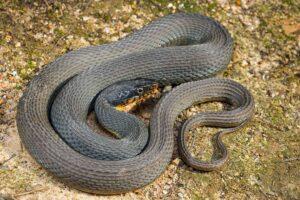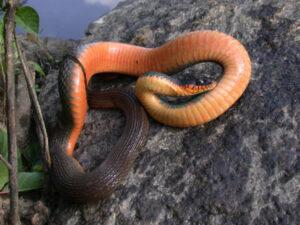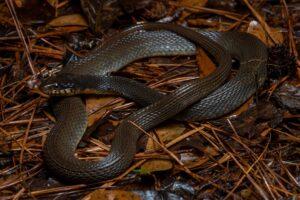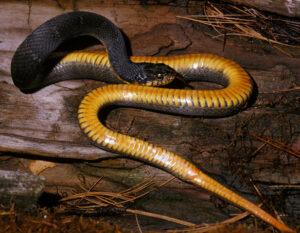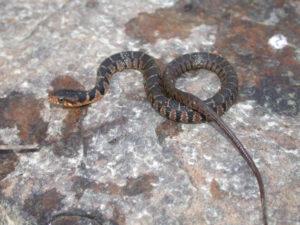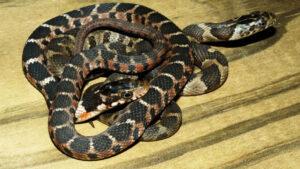Plain-bellied Water Snake (Nerodia erythrogaster)
Updated on
25/04/2024Plain-Bellied Water Snake, also known as the plainbelly water snake, is a harmless large snake native to the southeastern United States. It is a common species often found basking in and around water in its habitat range.
Scientific Classifications
- Suborder:Serpentes
- Family:Colubridae
- Genus:Nerodia
- Species:N. erythrogaster
Conservation Status
Subspecies
There are 6 recognized subspecies:
- Redbelly water snake (Nerodia erythrogaster erythrogaster) – nominate subspecies
- Plainbelly water snake (Nerodia erythrogaster alta)
- Bogert’s water snake (Nerodia erythrogaster bogerti)
- Yellowbelly water snake (Nerodia erythrogaster flavigaster)
- Copperbelly water snake (Nerodia erythrogaster neglecta)
- Blotched water snake (Nerodia erythrogaster transversa)
Description
Size
Their size may vary from one subspecies to another, with adults growing anywhere between 24 inches and 40 inches long.
Color and Appearance
These snakes have a solid-colored body, varying from brown and olive green to gray and black among the subspecies. They all have a heavy, thick body, with some lighter snakes displaying darker markings on their back.
The common name ‘plain-bellied’ water snake comes from their plain, light, unmarked belly, which can be reddish-orange to yellow. The N. e. erythrogaster or redbelly watersnakes have reddish bellies. In fact, the name ‘erythrogaster’ itself means ‘redbelly’ as it originates from the Greek words’ erythros’ (red) and ‘gaster’ (belly)
Are they Dangerous to Humans
They do not pose any threats to humans or pets. Still, if cornered, they would be quick to defend themselves by repeatedly striking, biting, and flattening their heads.
It should be noted that this is not an aggressive species, and the snakes would try to run away in case of any human encounter. Almost all redbelly water snake bites happen when the snakes are intentionally assaulted or cornered.
Plain-Bellied Water Snakes at a Glance
Distribution
All the southeastern US states, on the east coast from Florida to southeast Virginia, to eastern parts of North Carolina to western Tennessee, and Oklahoma and Texas in the west. They are not found in the higher elevations of the Appalachian Mountain Range.
Habitat
Near lakes, ponds, rivers, floodplains, and any other permanent water source within their range.
These snakes are active both day and night on the hottest summer days. They can often be found swimming, basking near waterbodies, on logs and rocks, swimming, or moving around on land. During these hot and humid months, they often travel far from their watery habitats, spending more time on land than any other water snake.
They hibernate under rocks or in burrows near water during the coldest days of winter.
Lifespan
They live for 8 to 14 years in captivity; lifespan in the wild is still to be recorded.
Predators
Cottonmouths, kingsnakes, largemouth bass, egrets, and birds of prey like hawks When they face a predator, their first instinct is to try and run away, and unlike other water snakes, they tend to get out of the water and try to run by way of the land.
When unable to run, they bite their enemy and may sometimes secrete a foul-smelling musk.
Diet
Mostly amphibians, including salamanders and frogs; also feeds on fish and crayfish.
Since they spend a lot of time on land near waterbodies, amphibians make up a significant portion of their diet. These water snakes stay submerged in water, waiting to ambush their prey, though they may also actively hunt.
They are known to swallow their prey whole instead of killing it first.
Reproduction
Ovoviviparous (females give birth to live young after the eggs hatch inside their body)
The breeding season lasts from April to June, with females giving birth to broods of 5 to 30 young snakes, with a typical brood consisting of around 18 babies. The gestation period is of 4-7 months.
Juveniles are 8 to 13 inches (20-33 cm) long, with banded markings similar to banded water snakes. Their unmarked bellies are the primary identifying feature.
The mother leaves them after giving birth. Both males and females reach sexual maturity when they are 3-4.
Similar Species
Vs. Cottonmouth
The heavy body and brownish coloration can often lead people to wrongly identify a plain-bellied water snake as a cottonmouth, also known as a water moccasin. And this causes them to kill the harmless snakes for no reason.
However, there are some distinct differences between the two, including the thicker neck of plan-bellied water snakes, compared to cottonmouths, which have a narrower neck.
The water snakes also have smaller and flatter heads, while cottonmouths have a block-shaped wider head. The former also has a comparatively slender body.
Source
reptilehow.com, msherps.com, srelherp.uga.edu, animaldiversity.org, webapps.fhsu.edu

